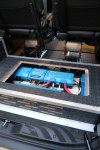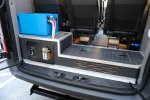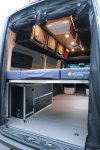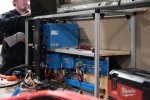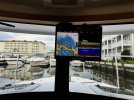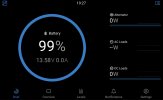freedomvango
Well-known member
I imagine this is going to be a lengthy post in numbers. I will document as I go so you can see if this, too, is something you want to tackle.
Problem - 2022 R23 with AGM Batteries, ac and heat that only works on shore power, single solar panel
Solution- Upgrade entire power system to support faster shore power charging, lithium charging from outboard, larger solar array, reconfigure breaker panel to run through larger inverter/charger
Parts list (abridged)-
-3 320 AH Dakota lithium batteries (what is current day used)
-1200w solar array on a custom rack that extends over Bimini
-Orion DC to dc charger for charging from outboard
-2x Victron 100/50 solar controllers
-multiplus 12/3000 inverter charger
-Cerbo GX and touch 70 for monitoring
-smart shunt IP67
-Ip22 charger for starting and thruster
-Class T fuse and holder
-random bus bars, wire, and the like.
The plan is to put the batteries and such where the factory ones are on the port side locker. This should work for r23 and 25s
Remove the charger, the ACR for house batteries,s and other unneeded items and replace them with those above
The inverter will be a little fun, but I think I can shove it where the factory inverter is. However, I will have to build a bezel to extend the panel a bit into that berth area to make depth for the inverter, but overall, it's not too hard. I will also most likely remake the facia panel on the CNC to rearrange the battery switches to under the AC Panel instead of beside it and slide things around for better packaging.
All the parts are at the shop except for the batteries which should show up by the end of the year.
While we are traditionally van builders, I love the ranger tug because its a van on a boat. fits right into my use case! Excited to start working on our 23.
Problem - 2022 R23 with AGM Batteries, ac and heat that only works on shore power, single solar panel
Solution- Upgrade entire power system to support faster shore power charging, lithium charging from outboard, larger solar array, reconfigure breaker panel to run through larger inverter/charger
Parts list (abridged)-
-3 320 AH Dakota lithium batteries (what is current day used)
-1200w solar array on a custom rack that extends over Bimini
-Orion DC to dc charger for charging from outboard
-2x Victron 100/50 solar controllers
-multiplus 12/3000 inverter charger
-Cerbo GX and touch 70 for monitoring
-smart shunt IP67
-Ip22 charger for starting and thruster
-Class T fuse and holder
-random bus bars, wire, and the like.
The plan is to put the batteries and such where the factory ones are on the port side locker. This should work for r23 and 25s
Remove the charger, the ACR for house batteries,s and other unneeded items and replace them with those above
The inverter will be a little fun, but I think I can shove it where the factory inverter is. However, I will have to build a bezel to extend the panel a bit into that berth area to make depth for the inverter, but overall, it's not too hard. I will also most likely remake the facia panel on the CNC to rearrange the battery switches to under the AC Panel instead of beside it and slide things around for better packaging.
All the parts are at the shop except for the batteries which should show up by the end of the year.
While we are traditionally van builders, I love the ranger tug because its a van on a boat. fits right into my use case! Excited to start working on our 23.

